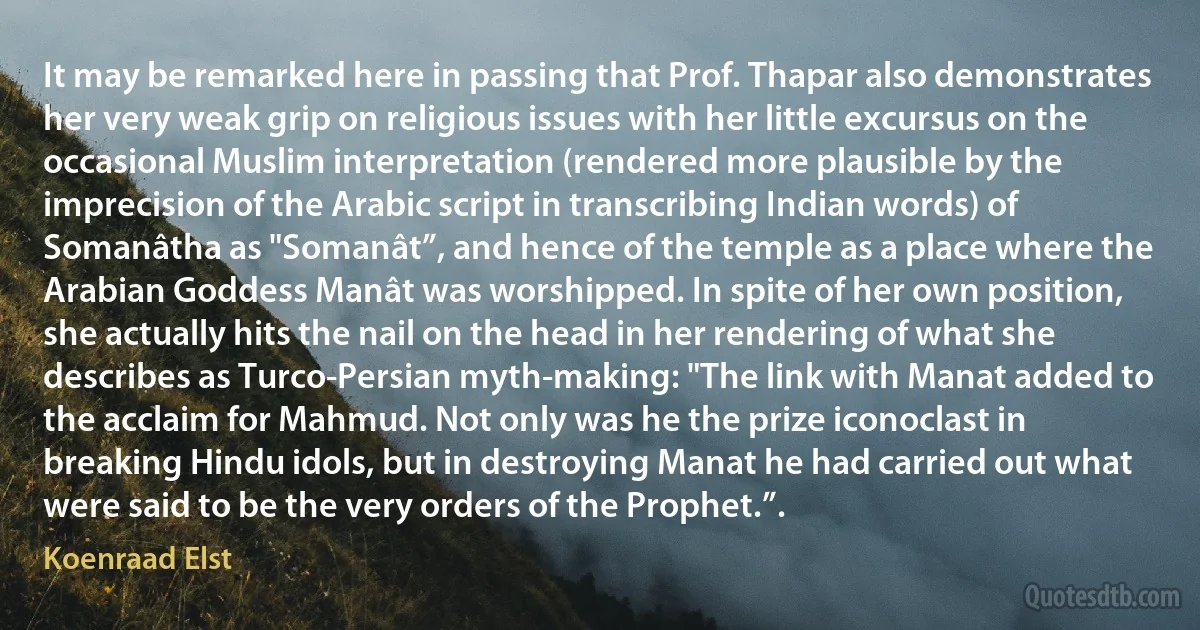
It may be remarked here in passing that Prof. Thapar also demonstrates her very weak grip on religious issues with her little excursus on the occasional Muslim interpretation (rendered more plausible by the imprecision of the Arabic script in transcribing Indian words) of Somanâtha as "Somanât”, and hence of the temple as a place where the Arabian Goddess Manât was worshipped. In spite of her own position, she actually hits the nail on the head in her rendering of what she describes as Turco-Persian myth-making: "The link with Manat added to the acclaim for Mahmud. Not only was he the prize iconoclast in breaking Hindu idols, but in destroying Manat he had carried out what were said to be the very orders of the Prophet.”.
Koenraad ElstRelated topics
acclaim breaking carry head hindu iconoclast imprecision interpretation link nail passing place position prophet rendering say script worship prof words hitsRelated quotes
The Hindus' sense of gratitude knows no bounds to Muslim rulers like Zayn al-‘Abidin (1420-70) of Kashmir, ‘Alau d-Din Husayn Shah (1493-1519) of Bengal, and Akbar the Great Mughal, who behaved towards Indians as Indians and at whose hands they could heave a sigh of relief from religious persecution. The three rulers tried their utmost to Indianize their rule and restore the dignity of Hindu community and culture, the latter essaying the uphill task of integrating Islam therewith, followed in this behalf by Prince Dara Shukoh. Who that has even the faintest sense of history can dispute the point that they were all intensely Indian, putting many a Hindu to shame in their patriotic fervour.

Dara Shukoh
The extreme ignorance and gullibility of the foreign press provides the negationists with a strategic cover. Most English-knowing Indians believe that the Western intelligentsia is more objective and competent, and they keep on believing this even in domains where the West is completely ignorant and incompetent. So the negationists feel supported in the back by an outside world which they can manipulate but which many in India still consider as a standard of truth. If the Hindu leadership had taken the trouble of studying the mental determinants of India's political configuration, it would have blown this cover away by spreading first-hand information to the foreign media, and educating them about the Stalinist-Islamic grip on the Indian establishment.

Koenraad Elst
The terrible situation of the country makes my mind restless and I cannot keep silent. Meaningless ritual keep the Hindus divided in hundred sects. Sop we are suffering from series of defeats. We are tired and worn-out by the fortunes by the internal external enemies. The Muslims are united in religion and rituals. The Bengali Muslims the South Indian Muslims and even the Muslims outside India-all are united. They always stand untied in face of danger. The broken and divided Hindus will not be able to combat them. Days are coming when the Hindus will be again humiliated by the Muslims. "You are a mother of children, one day you will die, passing the future of Hindus society on the weak shoulders of your children, but think about their future."

Rabindranath Tagore
It is one of the great achievements of our rule in India that, even if they do not entirely carry them out, educated Indians do accept British principles of justice and liberty. We are condemned by Indians not by the measures of Indian ethical conceptions but by our own, which we have taught them to accept. It is precisely this acceptance by politically conscious Indians of the principles of democracy and liberty which puts us in the position of being able to appeal to them to take part with us in the common struggle; but the success of this appeal and India's response does put upon us the obligation of seeing that we, as far as we may, make them sharers in the things for which we and they are fighting.

Clement Attlee
Anyone familiar with my work knows that I am extremely critical of all religious faiths. I have argued elsewhere that the ascendancy of Christian conservatism in American politics should terrify and embarrass us. And yet, there are gradations to the evil that is done in name of God, and these gradations must be honestly observed. So let us now make sense of the impossible by acknowledging the obvious: there is a direct link between the doctrine of Islam and Muslim terrorism. Acknowledging this link remains especially taboo among political liberals..... While the other major world religions have been fertile sources of intolerance, it is clear that the doctrine of Islam poses unique problems for the emergence of a global civilization.

Sam Harris
